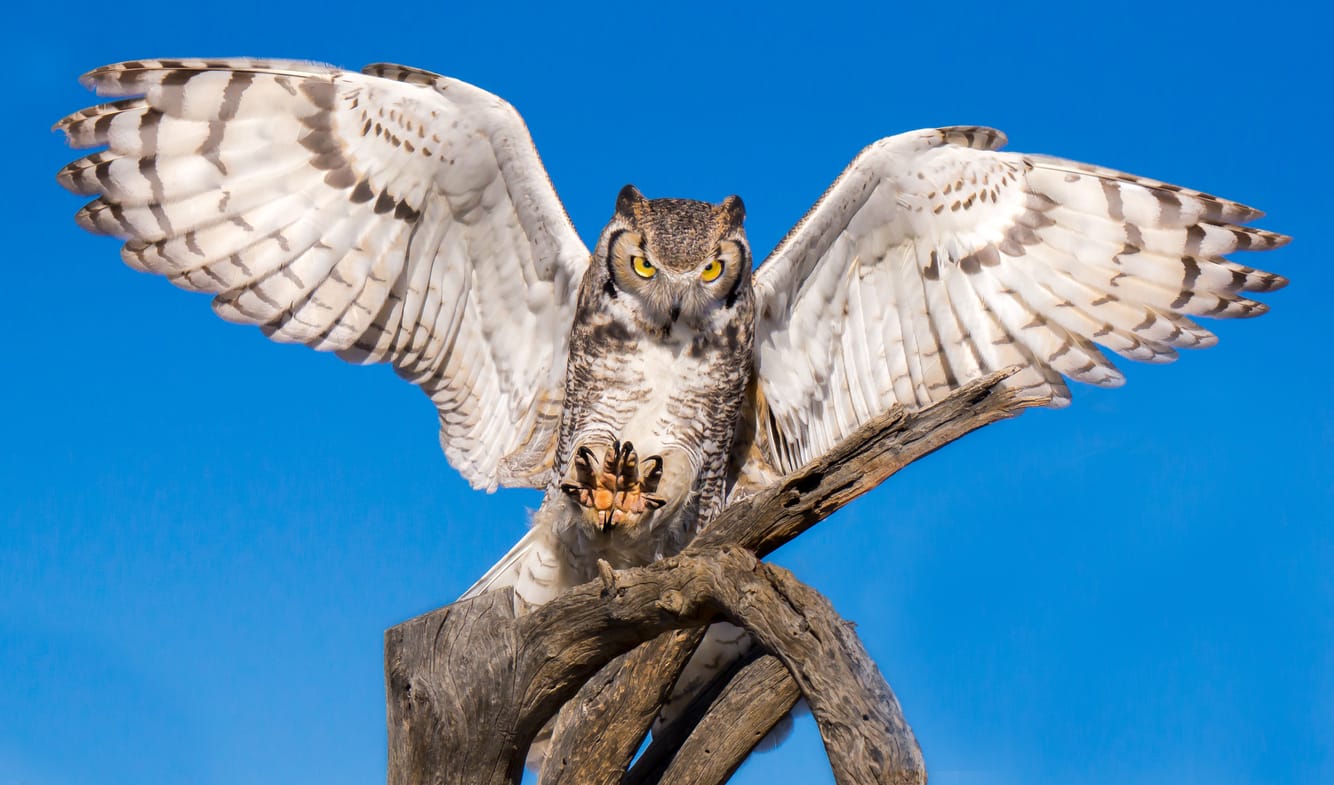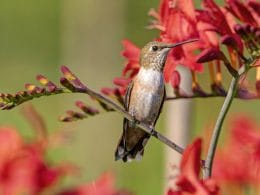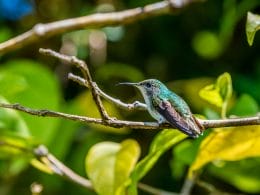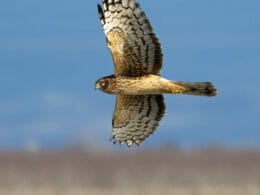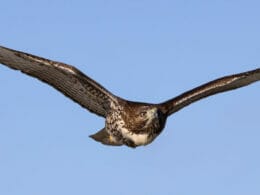Owls hold a sacred place in several cultures. In ancient Greek mythology, the Goddess Athena made the owl her favorite bird, and it became a good omen in wars, while in English folklore, the Barn Owl holds a unique place as a bird of darkness and death.
Luckily, if you’re a Georgia resident or visiting it, you have a chance to check out eight different owl species that are present across the state. Keep on reading to learn more about them.
8 Species of Owls in Georgia
Georgia is known as the Peach State, and it’s America’s number one producer of pecans and peanuts. It’s also home to about 427 bird species that you can watch and study.
But if you’re interested in owls, you’ve come to the right place because we’ll list the 8 owl species that call Georgia their home.
1. Great Horned Owl

The Great Horned Owl is found all year round in Georgia, making its deciduous forests its home. It roosts during the day, as the markings on its body provide the perfect camouflage, and at night hunts larger animals.
A female owl is usually larger than the male, but the male has a deeper voice. A pair might call together, but their calls have different pitches.
You can easily recognize the Great Horned Owl because of its deep hoot and feathered tufts that people mistake for ears.
Keep an eye on open areas and swamps as this owl is likely to target mice, lizards, scorpions, shrews, chipmunks, rabbits, and even birds, including crows, ravens, starlings, and doves.
Crows usually gather to mob this owl because it’s their greatest and most dangerous predator.
Author Note: Thanks to its size, this bold raptor doesn’t mind targeting other birds of prey, like Prairie Falcons, Ospreys, and Peregrine Falcons, in addition to smaller owls.
The clenched claws of the Great Horned Owl require a force of 28 pounds to open, and the owl uses its powerful claws to sever the spine of a large animal or bird easily.
In some cases, this owl will target prey that can potentially harm it. For example, hunting a rat snake or a porcupine doesn’t usually end well for the Great Horned Owl.
It’s probably one of the few owls that enjoy hunting skunks because it has a poor sense of smell and doesn’t mind eating a skunk that emits a bad odor in case of danger.
2. Barn Owl
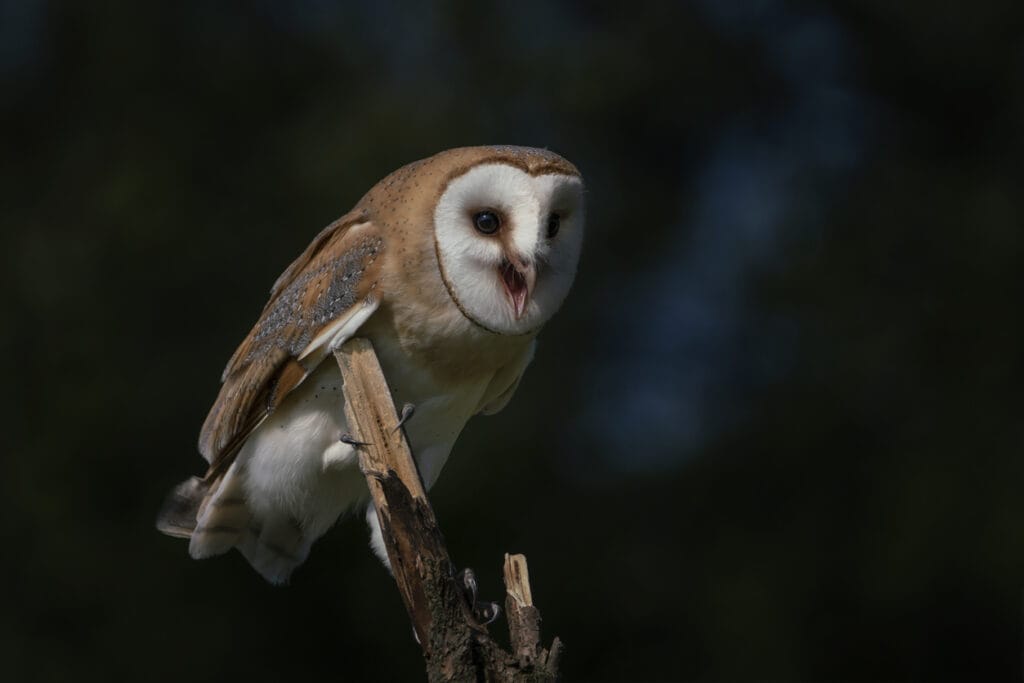
The Barn Owl can be found across the agricultural region throughout Georgia and can be easily identified thanks to its heart-shaped face. The head has a smooth appearance as it lacks the tufts that other owls have.
Just as the name suggests, this owl likes to roost in barns, but it also roosts in tree hollows. Then, it flies to hunt in fields and marshes.
Its favorite prey includes small mammals, rodents, and birds. It feeds on rabbits, mice, voles, bats, mockingbirds, and starlings.
Animals that sleep early are safe from this skilled hunter because it hunts at night. When this owl lays eggs, it stores its prey in a tree cavity until the eggs hatch.
The Barn Owl has a shrieking call that it usually calls at dusk or dawn. This unsettling scream annoys most people but can help you locate this owl. If you’re looking for this owl during the day, check out the barks of dead trees and you might spot one.
The Barn Owl swallows its prey as a whole and coughs out pellets that contain the indigestible remains about twice a day.
Female Barn Owls are showier than males and get fewer parasites. This owl has excellent vision but relies on its sensitive hearing to locate its prey in pitch-black darkness.
3. Eastern Screech-Owl

The Eastern Screech-Owl is found in the urban and rural areas as long as it can find mature trees. It’s a small owl with a gray-reddish plumage that creates the perfect camouflage as it hides among the crannies found in mature tree trunks.
Top Tip: If you’re interested in locating the Eastern Screech-Owl, your best chance would be to pay attention to its call during the first hours of the night. It usually hunts along the edges of wetlands, open fields, and woodlands, where it hunts small mammals and rodents.
But this owl can also target frogs and crayfish.
Unlike other owls, the Eastern Screech-Owl isn’t intimidated by humans. As a matter of fact, you can attract a breeding pair to your backyard if you have holes in old trees that woodpeckers or squirrels previously excavated. You can also set up a nesting box to attract a breeding pair.
Male owls are slightly smaller than females, but they’re better hunters. The male also has a deeper voice than the female owl.
When the female is spending time in the nest after laying the eggs, it doesn’t hunt and relies on the food brought by the male.
4. Barred Owl

Just like most owls, the Barred Owl prefers to roost in tree cavities. This is why you’ve got a great chance of locating one by searching the evergreen and deciduous woods of Georgia.
The mixed brown and white plumage allows it to hide during the day and at night when it’s targeting its prey. Although this owl is an all-year Georgia resident, you have a better chance of encountering one during the mating season in spring and summer.
Compared to the other owls in Georgia, the Barred Owl has an impressive lifespan that can reach up to 24 years. It has a distinctive “who cooks for you?” call that sets it apart from other owls.
A lot of birders have tried to imitate this call, and some of them were able to attract a Barred Owl to their location. The call can be heard up to a distance of 0.5 miles and is what you can hear in movies when an owl is present.
It’s fond of cavities, so setting up a nesting box in your backyard will definitely make it consider your backyard as its potential home. During the day, this owl is subject to mobbing by woodpeckers and mammals. It feeds on small mammals and invertebrates, but it might consider fish and amphibians when food is scarce.
5. Snowy Owl

According to avid birders, only a few members of this species have visited Georgia in a period that spanned almost a century. But if you’re lucky enough to spot a Snowy Owl, you’ll quickly recognize it thanks to its overall white plumage.
Male birds tend to be whiter than the females that show other colors in their plumage. In addition, the birds tend to get whiter as they age.
Compared to other owls, the Snowy Owl is larger and has a round face. You can keep an eye on fields, airports, and near water bodies, and you might get lucky enough to spot a Snowy Owl. You might see it walking on the ground. As a matter of fact, this owl can actually sprint.
Top Tip: This owl is more likely to travel south in winter, so keep an eye on the open fields. It has a strong call and can be heard as far as 6.8 miles away.
The Snowy Owl hunts lemmings in winter but feeds on rabbits, voles, and waterbirds in summer. It also feeds on fish and amphibians.
This owl swallows its prey as a whole, regardless of its size, and then it regurgitates the remains in oval pellets. Scientists study these pellets to study the owl’s range and behavior.
6. Short-eared Owl
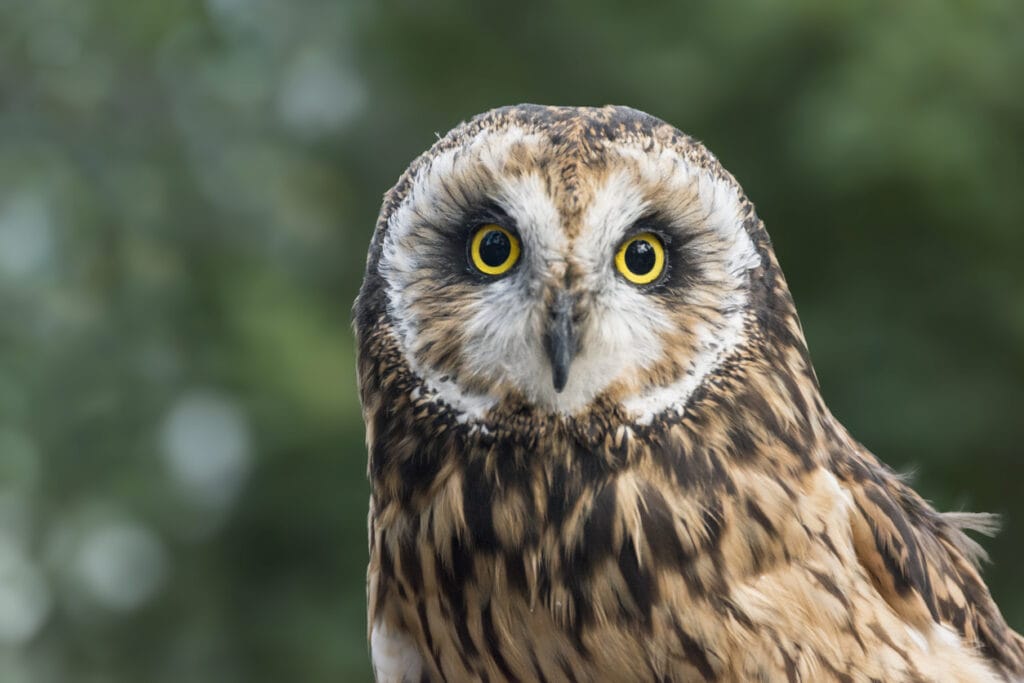
The Short-eared Owl has a brown-buff plumage and short ear tufts that aren’t always easy to see. It’s known to be crepuscular and diurnal, although most of its hunting is done at night.
Just keep an eye on meadows, grasslands, fields, and even airports at dusk or dawn, and you’re likely to spot this owl hopping on the ground.
This owl feeds on rodents like voles, mice, rats, and shrews. It also occasionally attacks shorebirds and songbirds, while juveniles usually feed on insects.
Although it prefers hunting in low light conditions, during the mating and breeding season, the owl stays active all day long. It looks for a dry location to build its nest and will pick a spot that’s properly concealed with low vegetation.
It’s one of the few owls that actually builds its nest.
Because it’s smaller than other birds of prey, it can be attacked by the Snowy Owl and the Bald Eagle. The nest is also subject to the attacks of dogs, crows, and foxes that steal the eggs.
But the Short-eared Owl follows a unique way to conceal the nest and protect the eggs. It defecates on the eggs, hoping that the bad odor will drive predators away.
It spends most of its time on the ground and flies low, compared to other owls.
7. Northern Saw-whet Owl
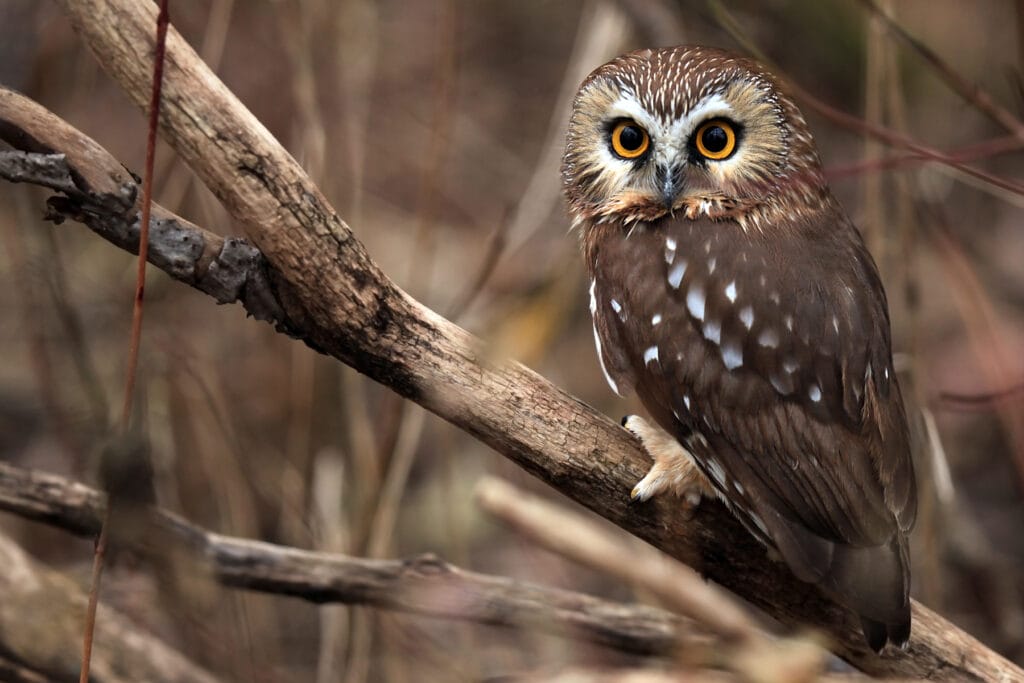
The Northern Saw-whet Owl gets its name from its call, which sounds like a saw being sharpened on a whetting stone. It’s a small owl with a mottled brown body and bright yellow eyes.
This is a shy owl that prefers to hide in densely wooded areas. Due to its small size, this owl feeds on small rodents and mammals like voles, white-footed mice, squirrels, and shrews, but it targets small songbirds during the migration season and doesn’t mind feeding on insects.
The head appears quite large compared to the body, which gives this owl a cartoonish and less intimidating look. Even songbirds don’t fear this owl that much, and they usually gather to mob an owl when it’s located.
Bigger birds of prey like the Great Horned Owl and Cooper’s Hawk usually target the Northern Saw-whet Owl.
Author Note: This owl has a unique way of locating its prey accurately. The ears are asymmetrical, and this allows the sound to reach both ears at different times. This way, the owl will locate its prey in total darkness with no chance of error.
The Northern Saw-whet Owl can be found in the forests of Georgia, but you have a better chance of locating it during the migration season, where it’s likely to look for a new home.
One of the easiest ways to locate a Northern Saw-whet Owl is to pay attention to songbirds in the area. They usually emit alarming calls when this owl is spotted until it’s gone.
8. Burrowing Owl

The Burrowing Owl has a plumage that appears as a mix of mottled brown, white, and sandy tan. The belly and breast show a barred pattern, and the striking bright yellow eyes and white eyebrows make the owl easier to spot.
Although in most species female owls are larger than males, in this species, both sexes are of the same size. It’s a small owl and prefers to live in the prairies and sparsely vegetated areas, especially between October and April.
It burrows on the ground, and this is how it gets its name. It usually resides in the discarded homes of different animals, like ground squirrels, prairie dogs, and tortoises.
There’s a great relationship between the numbers of ground squirrels and prairie dogs in the area and the numbers of Burrowing Owls that are likely to reside in the same region.
Unlike other owls, this one is a daytime owl. The Burrowing Owl hops on the ground and forages for insects or lizards when it’s looking for a snack, but it prefers to feed on rodents and mammals like most owls.
Because it hunts in daylight, this owl prefers to hunt close to vegetation to find shelter in case a large predator approaches. It stores rodents in its underground storage dens to guarantee that it will have enough food throughout winter.
In some cases, it can store hundreds of rodents in its den.
Wrap Up
There are eight owl species that can be found in Georgia. Some of them are rare, but others will make themselves noticeable in your backyard. Pay attention to the different calls of these owls, and you’ll be able to locate and tell them apart.
We hope you enjoyed this article on the most common owls in Georgia!
FAQ
According to Georgia Wildlife, the most common Georgia owl is the Eastern Screech-Owl. It is a great owl to look for as it inhabits rural and domestic locations.
The Great Horned Owl is the largest owl in the U.S. and Georgia. It weighs 3 pounds which is a huge amount for a land based bird. Consider that the American Robin weighs less than 3 ounces!
The Great Horned Owl takes the prize again. These birds look cute but are vicious predators. They can kill other birds of prey like hawks.




